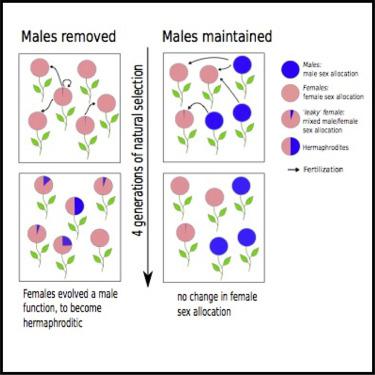Current Biology ( IF 9.2 ) Pub Date : 2021-01-19 , DOI: 10.1016/j.cub.2020.12.028 Guillaume G Cossard 1 , Jörn F Gerchen 1 , Xinji Li 1 , Yves Cuenot 1 , John R Pannell 1

|
Evolutionary transitions from hermaphroditism to dioecy have been common in flowering plants,1,2 but recent analysis also points to frequent reversions from dioecy to hermaphroditism.2, 3, 4 Here, we use experimental evolution to expose a mechanism for such reversions, validating an explanation for the scattered phylogenetic distribution of dioecy. We removed males from dioecious populations of the wind-pollinated plant Mercurialis annua and allowed natural selection to act on the remaining females that occasionally produced male flowers; such “leaky” sex expression is common in both males and females of dioecious plants.5 Over the course of four generations, females evolved a 23-fold increase in average male flower production. This phenotypic masculinization of females coincided with the evolution of partial self-fertilization, high average seed set in the continued absence of males, and a capacity to sire progeny when males were re-introduced into their populations. Our study thus validates a mechanism for the rapid dissolution of dioecy and the evolution of functional hermaphroditism under conditions that may frequently occur during periods of low population density, repeated colonization, or range expansion.6,7 Our results illustrate the power of natural selection, acting in replicated experimental populations, to bring about transitions in the mating behavior of plants.
中文翻译:

通过实验进化快速溶解雌雄异体
从雌雄同体到雌雄同体的进化转变在开花植物中很常见,1 , 2但最近的分析也指出从雌雄同体到雌雄同体的频繁逆转2, 3, 4 在这里,我们使用实验进化来揭示这种逆转的机制,验证解释了雌雄异株分散的系统发育分布。我们从风授粉植物Mercurialis annua的雌雄异株种群中去除雄性,并让自然选择作用于偶尔产生雄花的剩余雌性;这种“泄漏”的性表达在雌雄异株植物的雄性和雌性中都很常见。5在四代的过程中,雌性雄性花的平均产量增加了 23 倍。雌性的这种表型男性化与部分自我受精的进化、在雄性持续缺席的情况下平均种子高、以及当雄性重新引入其种群时产生后代的能力相吻合。因此,我们的研究验证了在人口密度低、反复定殖或范围扩大期间可能经常发生的条件下,雌雄异体快速解体和功能性雌雄同体进化的机制。6 , 7我们的结果说明了自然选择的力量,在重复的实验种群中起作用,以实现植物交配行为的转变。



























 京公网安备 11010802027423号
京公网安备 11010802027423号